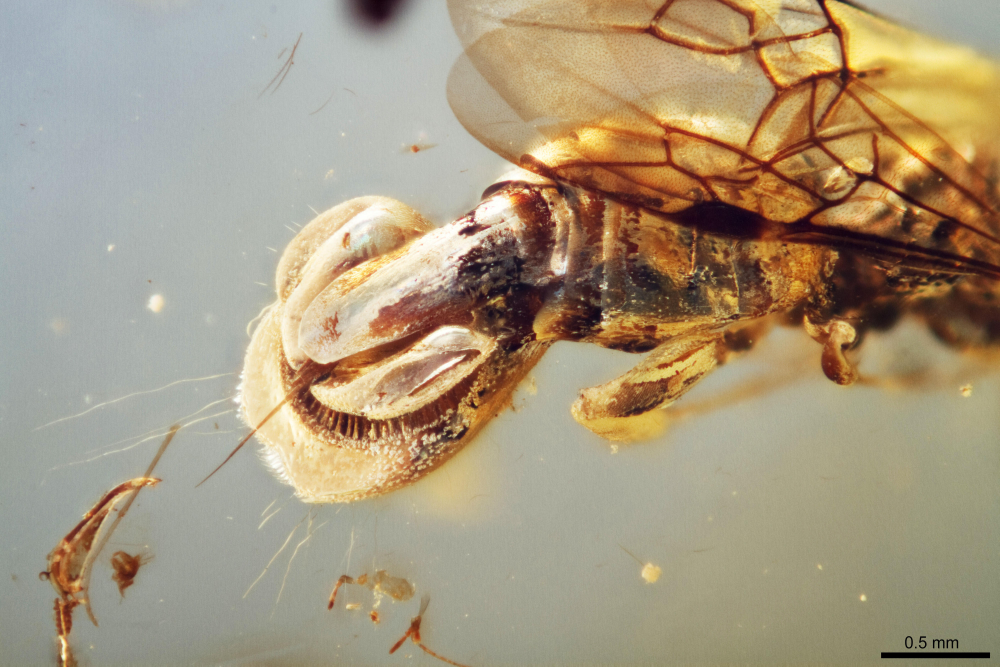We know that life was strange back in the mid-Cretaceous. There were dinosaurs, fine. They were even in Antarctica, which was covered in temperate rainforest, lovely. My brain is struggling to grapple with the latest addition to this otherworldly image, however, as scientists have revealed to the world amber fossils of a wasp that was basically wearing a Venus flytrap like a fanny pack. This weaponized bit of a kit was a way of snatching hosts to lay its eggs in, and even the researchers couldn’t believe what they were seeing.
ADVERTISEMENT
The wasp hails from an extinct lineage of parasitic wasps, and is unlike anything we’ve seen before in insects. It’s been named Sirenobethylus charybdis, after the Greek sea monster Charybdis that had the strange habit of swallowing and disgorging water throughout the day.
There was not much point in evolving this elaborate device if it was targeting slow-moving caterpillars.
Dr Lars Vilhelmsen
Sirenobethylus was doing some catch-and-release of its own, but not with water. As a parasitic wasp it needed to capture hosts in which to lay its eggs, and it seems the strange piece of apparatus around its waist enabled it to grab onto them long enough to get the job done. As for what kind of hosts it was grabbing?
“Impossible to say for certain,” said study author Dr Lars Vilhelmsen, of the Natural History Museum of Denmark and University of Copenhagen, to IFLScience. “We are guessing that it was catching something that was comparatively fleet-footed, i.e, a flying or a jumping insect like a cicada; there was not much point in evolving this elaborate device if it was targeting slow-moving caterpillars.”

This is the last thing those flies saw before a wasp went and shoved an egg in them.
Image credit: Qiong Wu
If you’re still reeling from the idea of a wasp basically wearing a Venus flytrap like a fanny pack, you’re not alone. Even the researchers struggled to contend with what they were looking at when they first studied the amber fossil.
“I could not believe my eyes,” said Vilhelmsen. “At first glance, I thought I was looking at an air bubble trapped close to the abdomen of the specimen (a common occurrence in amber). After checking a few more specimens in more detail, I realized ‘this is real’. Working out the details of the morphology and deducing the possible function took many hours, comparing the different specimens.”
ADVERTISEMENT
The team had 14 specimens of this peculiar wasp to work from in total, all belonging to the same extinct lineage of parasitic wasp that was ovipositing animals of the mid-Cretaceous. The trap at its waist isn’t a literal plant, but an anatomical adaptation that mirrors the snatching capacity of a Venus flytrap. The fossils shine fresh light on the solutions dreamt up by parasitic wasps in Earth’s history, showing that they were getting creative much earlier on than we realized.
It is possible that early parasitoid wasps were more sophisticated and adaptable than we had imagined.
Dr Taiping Gao
“In modern carnivorous insects, various host-capturing mechanisms have evolved,” said Dr Taiping Gao, College of Life Sciences, Capital Normal University, to IFLScience. “However, fossil evidence of potential prey capture strategies in parasitoid wasps remains scarce. The discovery of this new group suggests that early parasitoid strategies may have been even more diverse than previously thought.”
ADVERTISEMENT
“It is possible that early parasitoid wasps were more sophisticated and adaptable than we had imagined. Early parasitoid wasps may have been smarter than we thought.”
Smart wasps with weaponized bumbags? Count me out, Cretaceous.
The study is published in the journal BMC Biology.
Source Link: Monstrous 99-Million-Year-Old Wasp Had Inbuilt "Venus Flytrap" For Snatching Victims